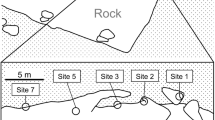Synopsis
At Sesoko Island, stocks of anemonefishes were observed for 2 years in a 350 m × 150 m area where host sea anemones were sparse. About 40% of the pairs separated, mostly due to typhoon attacks or displacement. Widowed mates remained and acquired new mates on the same sea anemone, except for one case. New mates were immigrant adults inAmphiprion clarkii and A.frenatus, but resident juveniles inA. perideraion. A. clarkii andA. frenatus moved between sea anemones and sometimes displaced smaller consexuals, butA. perideraion rarely moved. The difference in mobility among the 3 species was related to the mean difference in standard length between the largest juveniles in breeding groups and the minimum size of breeding males in each species, and that between breeding males and the minimum size of breeding females. InA. perideraion both of these differences were small, so pairs could be formed quickly by residents after mate loss. On the contrary, inA. clarkii andA. frenatus, either or both differences were large and it would take a longer time to form a pair after mate loss. Differences in mobility affected the patterns of pair formation, and then the size composition of members in breeding groups.
Similar content being viewed by others
References
Allen, G.R. 1975. Anemonefishes: their classification and biology. 2nd Edition. T.F.H. Publications Neptune City. 352 pp.
Allen, G.R. 1991. Damselfishes of the world Mergus Publishers Melle. 271 pp.
Dunn, D.F 1981. The clownfish sea anemones: Stichodactylidae (Coelenterata: Actiniaria) and other sea anemones symbiotic with pomacentrid fishes. Trans. Amer. Phil. Soc. 71: 1–115.
Fautin, D.G. & G.R. Allen. 1992. Field guide to anemonefishes and their host sea anemones Western Australian Museum Perth. 160 pp.
Fricke, H.W. 1974. Öko-Ethologie des monogamen AnemonefischesAmphiprion bicinctus. (Freiwasseruntersuchung aus den Roten Meer). Z. Tierpsychol. 33: 429–512.
Fricke, H.W. 1979. Mating system, resource defence and sex change in the anemonefishAmphiprion akallopisos. Z. Tierpsychol. 50: 313–326.
Fricke, H.W. 1983. Social control of sex: field experiments with the anemonefishAmphiprion bicinctus Z. Tierpsychol. 61: 71–77.
Fricke, H.W. & S. Fricke. 1977. Monogamy and sex change by aggressive dominance in coral reef fish. Nature 266 (5605): 830–832.
Hattori, A. 1991. Socially controlled growth and size-dependent sex change in the anemonefishAmphiprion frenatus in Okinawa, Japan. Japan. J. Ichthyol. 38: 165–177.
Hattori, A. & Y. Yanagisawa. 1991. Life-history pathways in relation to gonadal sex differentiation in the anemonefishAmphiprion clarkii, in temperate waters of Japan. Env. Biol. Fish. 31: 139–155.
Hirose, Y. 1985. Habitat, distribution and abundance of coral reef sea-anemones (Actiniidae and Stichodactylidae) in Sesoko Island, Okinawa, with notes on expansion and contraction behavior. Galaxea 4: 113–127.
Masuda, H., K. Amaoka, C. Arage, T. Uyeno & T. Yoshino (ed.). 1984. The fishes of the Japanese Archipelago. Tokai University Press, Tokyo. 437 pp.
Moyer, J.T. 1976. Geographical variation and social dominance in Japanese populations of the anemonefishAmphiprion clarkii. Japan. J. Ichthyol. 23: 12–22.
Moyer, J.T. 1980. Influence of temperate waters on the behavior of the tropical anemonefishAmphiprion clarkii at Miyake-jima. Bull. Mar. Sci. 30: 261–272.
Moyer, J.T. 1986. Longevity of the anemonefishAmphiprion clarkii at Miyake-jima. Japan with notes on four other species. Copeia 1986: 135–139.
Moyer, J.T. & A. Nakazono. 1978. Protandrous hermaphroditism in six species of the anemonefish genusAmphiprion in Japan. Japan. J. Ichthyol. 25: 101–106.
Ochi, H. 1985. Temporal patterns of breeding and larval settlement in temperate population of the tropical anemonefish,Amphiprion clarkii. Japan. J. Ichthyol. 32: 248–257.
Ochi, H. 1986. Growth of the anemonefishAmphiprion clarkii in temperate waters, with special reference to the influence of settling time on the growth of 0-year olds Mar. Biol. 92: 223–229.
Ochi, H. 1989a. Mating behavior and sex change of the anemonefish,Amphiprion clarkii, in the temperate waters of Southern Japan. Env. Biol. Fish. 26: 257–275.
Ochi, H. 1989b. Acquisition of breeding space by nonbreeders in the anemonefishAmphiprion clarkii in temperate waters of Southern Japan Ethology 83: 279–294.
Ross, R.M. 1978. Territorial behavior and ecology of the anemonefishAmphiprion melanopus on Guam. Z. Tierpsychol. 46: 71–83.
Ross, R.M. 1990. The evolution of sex-change mechanism in fishes. Env. Biol. Fish. 29: 81–93.
Warner, R.R. 1984. Mating behavior and hermaphroditism in coral reef fishes. Amer. Sci. 72: 128–136.
Yanagisawa, Y. & H. Ochi. 1986. Step-fathering in the anemonefishAmphiprion clarkii: a removal study. Anim. Behav. 35: 1769–1780.
Author information
Authors and Affiliations
Rights and permissions
About this article
Cite this article
Hirose, Y. Patterns of pair formation in protandrous anemonefishes,Amphiprion clarkii, A. frenatus andA. perideraion, on coral reefs of Okinawa, Japan. Environ Biol Fish 43, 153–161 (1995). https://doi.org/10.1007/BF00002485
Received:
Accepted:
Issue Date:
DOI: https://doi.org/10.1007/BF00002485




